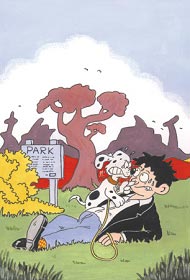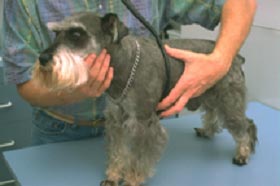What
makes a pet misbehave?
Behavior
problems can be due to medical
or behavioral causes, or both.
A clinical history, physical
examination, and diagnostic
testing will determine if there
are underlying medical conditions
contributing to the problem.
Although there may be a single
cause for a behavior problem
it is often the combined effect
of the environment and learning
on the pet's mental and
physical health that determines
behavior.
For
example, the pet that is fearful
of children, may begin to become
more reactive, irritable, and
aggressive as diseases such
as dental problems or arthritis
make the pet more uncomfortable,
in pain or less mobile.
Another
example is the cat that had
been exposed to other cats roaming
across its territory, but only
began to mark when it developed
an overactive thyroid at 10
years of age. Correcting the
thyroid problem as well as behavior
modification techniques resolved
the problem.
What
are some behavioral causes of
behavior problems? 
Any
change in the environment may
contribute to the emergence
of behavior problems. For example,
schedule changes, a new member
of the household (baby, spouse),
moving, loss of a family member
or pet, or the addition of a
new pet can have a dramatic
impact on behavior. Any medical
or degenerative changes associated
with aging may cause the pet
to be even more sensitive to
these environmental changes.
Learning
(e.g. reinforcement, punishment)
also plays a role in most behavior
problems. When a pet's
actions result in unpleasant
consequences (discomfort, lack
of attention) i.e. punishment,
the chances of repeating the
behavior will decrease. If the
behavior is followed by pleasant
consequences such as obtaining
food, attention, or affection
(rewards), the behavior is likely
to be repeated. These consequences
could occur unintentionally
when the pet gets into the garbage
and finds some appealing leftovers,
or could be administered by
the owners, when a reward is
given following a behavior.
It can be difficult to determine
what might be reinforcing a
behavior, but reinforcement
maintains behavior problems.
Some
of the most important causes
of behavioral problems and the
ones that might be most difficult
to improve are genetic factors
that influence or even dictate
the pet's response to
stimuli, and the environment
that the pet grew up in during
its most sensitive periods of
development including a) the
socialization period from 3
to 12 weeks b) prenatal and
neonatal experiences and c)
secondary socialization and
development through to maturity.
Lack of stimulation, lack of
handling, lack of exposure,
insufficient socialization,
and particularly stressful or
traumatic events can have a
major impact on the pet's
behavior.
What
tests can be done to determine
a behavioral cause?
A
good history is one of the most
important means of determining
the cause of a behavioral problem.
This involves an in depth analysis
of the pet's medical and
behavioral past including any
training, as well as the circumstances
surrounding the problem itself.
Daily interactions with the
pet and any changes in schedule
need to be explored. Often the
event that precipitated the
behavioral change may be different
from that which maintains it.
Based
on the behavioral problem, the
pet's age, and a physical
examination, the veterinarian
first determines if ther e are
any medical causes or contributing
factors. Diagnosis of a behavioral
cause can only be made after
all medical factors have been
ruled out.
 What
medical conditions can cause
or contribute to behavior problems? What
medical conditions can cause
or contribute to behavior problems?
A
decline in the pet's hearing,
sight or other senses, organ
dysfunction (e.g. liver or kidney
disease), hormonal diseases,
diseases affecting the nervous
system, diseases of the urinary
tract (infections, tumors or
stones), any disease or condition
that might lead to pain or discomfort,
and those that affect the pets
mobility can all cause or contribute
to behavior problems.
a)
Any condition that leads to
an increase in pain or discomfort
can lead to increased irritability,
increased anxiety or fear of
being handled or approached,
and ultimately an increased
aggressiveness. If these aggressive
displays are successful at removing
the "threat" (and
they usually are) the behavior
is reinforced. Medical conditions
that affect the ears, anal sacs,
teeth and gums, bones, joints,
or back (disks) are some of
the more common causes of pain
and discomfort. If the pet's
mobility is affected, it may
become increasingly aggressive,
choosing to threaten and bite,
rather than retreat. A decrease
in mobility could also affect
urination and defecation by
reducing the pet's desire
or ability to utilize its elimination
area.
b)
Sensory dysfunction:
Pets with diminished sight or
hearing may have a decreased
ability to detect or identify
the stimuli, and might begin
to respond differently to commands,
sounds or sights. Sensory decline
is more likely to be seen as
pet's age.
c)
Diseases of the internal organs,
such as the kidneys or liver,
can cause a number of behavior
changes, primarily due to the
toxic metabolites that accumulate
in the bloodstream. Organ decline
and dysfunction is more common
in the older pet. Any medical
conditions that cause an increased
frequency of urination or decreased
urine control, such as kidney
disease, bladder infections,
bladder stones, or neurological
damage might lead to an increase
in house soiling. Similarly,
those problems that affect the
frequency of bowel movements
or bowel control, such as colitis
or constipation might lead to
house-soiling with stools.
d)
Diseases of the nervous system
(brain and spinal cord) can
lead to a number of behavior
and personality changes. Conditions
such as epilepsy, brain tumors,
infections, immune and degenerative
diseases can all directly affect
a dog or cat's nervous
system and therefore its behavior.
In the older pet aging changes
can have a direct effect on
the brain, leading to cognitive
dysfunction and senility.
e) The endocrine
(hormone) system also plays
a critical role in behavior.
Over-activity or under-activity
of any of the endocrine organs
can lead to a number of behavior
problems. The thyroid and parathyroid
glands (in the neck), the pituitary
gland (in the brain), the adrenal
gland (by the kidneys), the
pancreas, and the reproductive
organs can all be affected by
conditions or tumors that lead
to an increase or decrease in
hormone production. Endocrine
disorders are more likely to
arise as the pet ages.
f)
The aging process is associated
with progressive and irreversible
changes of the body systems.
Although these changes are often
considered individually, the
elderly pet is seldom afflicted
with a single disease, but rather
varying degrees of organ disease
and dysfunction. Cognitive decline
and senility have also been
recognized in older dogs (and
perhaps cats). See our handout
on geriatric behavior problems
for more details.
What
tests need to be done to determine
if my pet's behavior problem
is due to a medical condition?
Clinical
history and physical examination
The
assessment begins with a clinical
history and physical examination.
Remember the history that you
provide may be the only way
to determine if there are behavioral
or medical changes that occur
in the home, so be certain to
mention any changes or problems
that you may have noticed in
your pet's behavior. If
you can catch the problem on
videotape, this can be a valuable
diagnostic aid for the veterinarian.
Based on the signs that you
report and the findings of the
examination, laboratory tests
and a more comprehensive examination
such as a neurological examination
or sensory testing may be required.
For some of these tests your
pet may need to be referred
to a specialist.
Medical,
surgical, dietary or pharmacologic
treatment
Before
beginning behavior therapy,
any medical problem that has
been diagnosed should be treated.
A change in diet or a drug trial
may be an important aspect of
differentiating a medical from
a behavioral cause (as a food
trial or steroid trial might
be used to rule out an underlying
allergic cause). Surgery may
also be indicated such as when
a tumor is diagnosed or when
castration is indicated to reduce
male sexually influenced behaviors.
Your veterinarian may commence
medical and behavioral treatment
for long standing behavior problems.
This client
information sheet is based on
material written by Debra Horwitz,
DVM, DACVB and
Gary Landsberg, DVM, DACVB.
© Copyright 2002 Lifelearn
Inc. Used with permission under
license. March 11, 2004. |